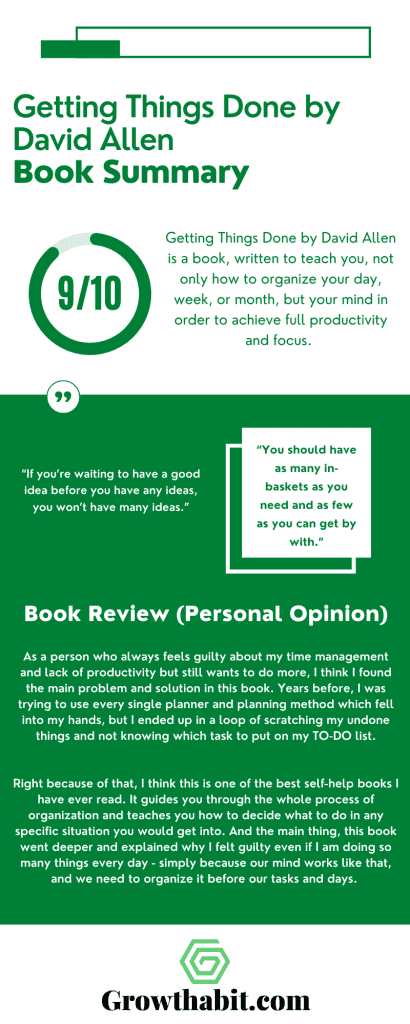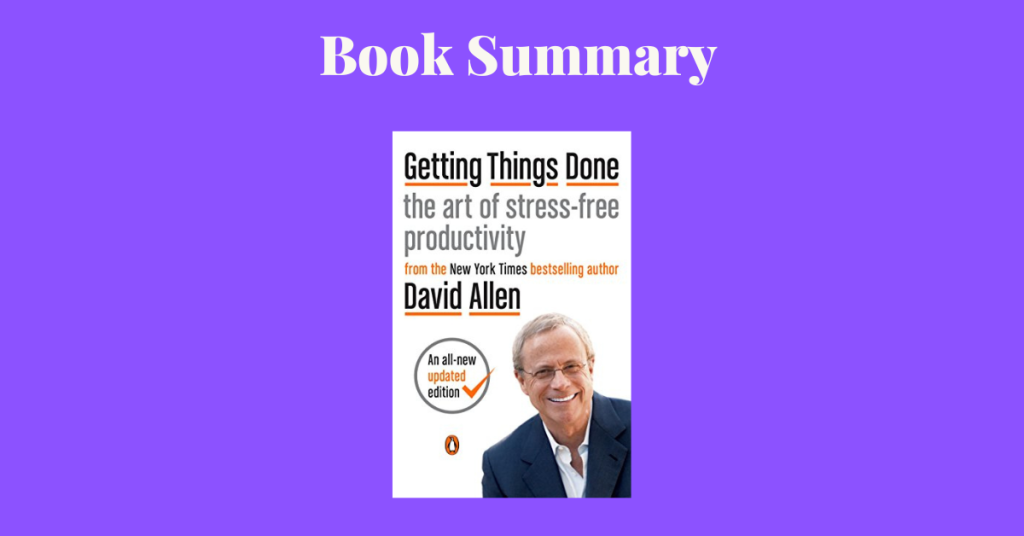Getting Things Done by David Allen is a book, written to teach you, not only how to organize your day, week, or month, but your mind in order to achieve full productivity and focus.
Book Title: Getting Things Done (The Art of Stress-Free Productivity)
Author: David Allen
Date of Reading: Feb 2023
Rating: 9/10
What Is Being Said In Detail:
This book talks about the flow of our thoughts, the most common way people are reacting when stuck in a bunch of tasks in every single area of life.
De facto, this is not only the book but a guide that will follow you through collecting and organizing your business and implementing this time management system as part of your lifestyle.
The book is divided into three parts and thirteen chapters in total. The first part talks in general about the GTD (Getting things done) system, the second is the action for practicing this system, and the third is about the main keys that you need to achieve if you want this system to work.
Part I – The Art of Getting Things Done
Chapter One: “A New Practice for a New Reality”
Chapter 1 introduces a new perspective on our thinking. And that is the main word, not only of this chapter but of the whole book – thinking. An oft-spoken platitude says everything is in your head, and that is the main problem but also the main answer.
As you already know, you need to organize your mind to stay calm and productive in every situation, but the new reality means that you need to stop thinking about things you need to do and rather think about the actions you need to take and DO that thing.
Chapter Two: “Getting Control of Your Life: The Five Stages of Mastering Workflow”
Chapter 2 describes five steps that we follow when dealing with any work. These are: collect, process, organize, review, and do.
Talking about the first step, it means that our mind collects a bunch of information and tries to keep it in our mind. We need to write it down in an appropriate bucket every time we get an idea in our minds.
The process represents processing every single thing you collect and understanding the next step you need to take about that task, and then comes organizing it. This step teaches you how to use your calendar, define your project and keep a bunch of materials, emails, and similar things.
Of course, to have a clean mind, you have to know your previous and next steps, meetings, and tasks, so you need to review your notes, reorganize, and clean them probably more often than you do now.
And in the end, you are going to learn how to decide what to do, depending on your time, context, as well as your life goals. This last step will bring you an explanation of how to look at all your wishes, and goals in life, no matter if you want to achieve them now or for ten years.
Chapter Three: “Getting Projects Creatively Under Way: The Five Phases of Project Planning”
Chapter 3 will explain to you how naturally our brain works when we talk about planning.
No matter if you are planning a simple dinner with your friend or a project about moving your company, your mind goes through five steps to accomplish virtually any task: Defining purpose and principles, Outcome visioning, Brainstorming, Organizing, and Identifying the next actions.
That means, before or after, you are going to plan anything that occupies your mind. The success key is to do it before overflowing your mind or blocking your ideas, energy, and productivity.
Part II – Practicing Stress-Free Productivity
Chapter Four: “Getting Started: Setting Up the Time, Space, and Tools”
Chapter 4 brings you a bunch of new information. At this point, you start with your system, so the three main things to be said are about time, space, and tools. Since this is the process of summarizing ALL your work, open projects, and obligations, you will need some free time to strategize with this.
Of course, you need your workspace, probably a desk, to be able to catch all of these things you will handle with. It is important to have your desk even at home but also to make it flexible enough to set up a mini workstation even on a plane or train.
And at the end, you need tools (paper, pencils, recycle bin, file folders, a calendar,…). That’s it – physical equipment. Now, it’s up to you to find out which kind of desk, drawer, or even pencil you like the most and feel comfortable using because that is the key – to enjoy doing these.
Chapter Five: “Collection: Corralling Your Stuff”
Chapter 5 leads you through the process of collecting all your stuff. It means you will have one “in-basket” in which you need to put every paper, file, book, or thing around you.
And after finishing this, in the same way, you need to clean up your head and put every thought on paper. Sounds easy, but it takes some time to think about all your work, responsibilities, and promises that may affect your focus and occupy your mind.
Chapter Six: “Processing: Getting “In” to Empty”
Chapter 6 is the end of your procrastination. It is time to manage all “In-basket” stuff. Do not do all of them, but decide if it’s trash, something that requires action, or just some material you need to store in the right place.
But the most important rule is: you need to process every stuff from your in-basket and you cannot put it back in. And the second gold rule, not just of this chapter, but the book: if the action requires less than two minutes to be done – do it now!
Chapter Seven: “Organizing: Setting Up the Right Buckets”
Chapter 7 is the moment when you actually start organizing your system. Usually, there are seven types of things you would organize and track:
• A “Projects” list
• Project support material
• Calendared actions and information
• “Next Actions” lists
• A “Waiting For” list
• Reference material
• A “Someday/Maybe” list.
So, this chapter brings you a guide on how to set up your projects, what information to put on your calendar, and where to keep nonactionable materials. The purpose is to make categories that work for you in order to a functional system.
Chapter Eight: “Reviewing: Keeping Your System Functional”
Chapter 8, as you can see, talks about reviewing your system. You don’t need to spend half of the day staring at it – and you won’t if it’s organized well. So, on daily basis, you need to finish your calendar actions and then focus on your next actions.
Sorted by categories, every list you have needs just a few seconds to find out what is your next thing to do. To feel that everything is under control, of course, you need to review the whole system, at least once a week.
Also, this isn’t required too much of your time because, with the previous steps, you make it clear and functional!
Chapter Nine: “Doing: Making the Best Action Choices”
Chapter 9 talks about the next situation: you finished your work and have two free hours. You also finished all your calendar actions, and now you have five actions from the “Next actions” list you can do.
How to decide which one to choose? The general rule is by these four criteria: context, time available, energy available, and priority. Of course, there would be a lot of random and unexpected things you would do, but that is life.
And in the end, you also need to choose some bigger steps than this one on a daily basis. So, there is a six-level model for organizing your life, visions, goals, and responsibilities.
Chapter Ten: “Getting Projects Under Control”
Chapter 10 talks about some deeper levels when it comes to doing your projects. It seems easy to organize the first level of your mind, but when you sit down for just a couple of minutes and think about one project you have, you will get the feeling that a lot of things aren’t under your control.
And so, if you have any new idea for that project or you feel that something isn’t under control, then you need more planning for it.
Part III – The Power of the Key Principles
Chapter Eleven: “The Power of the Collection Habit”
Chapter 11 gives you a psychological answer to the question about anxiety and being overwhelmed with your work. Most of the time, it is not the thing of too much business, but of your agreements with yourself.
You set something up and then break it. So, in order to stop that loop you need to: complete it, renegotiate it, or don’t make it at all.
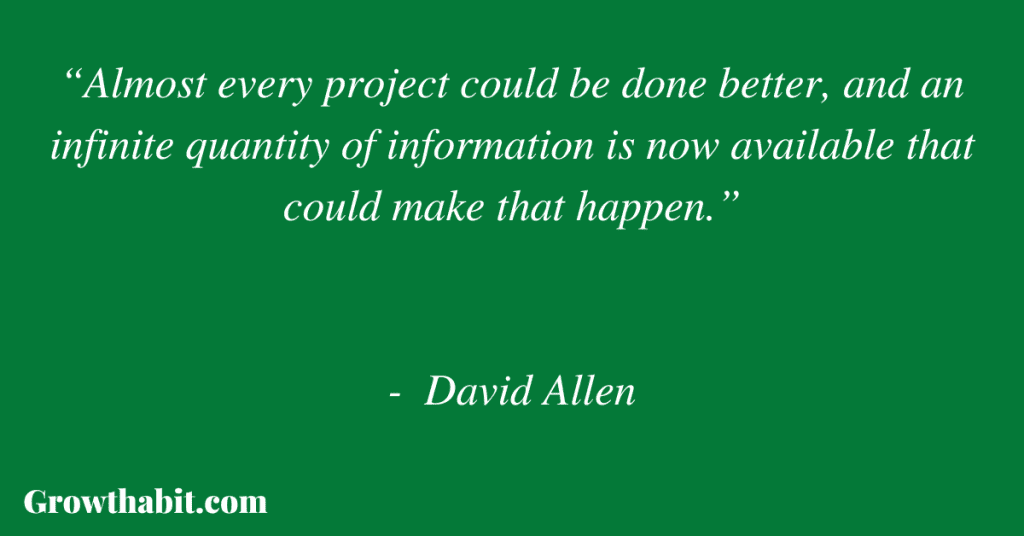
Sounds easy, but here is the secret: when you found out some new task you need to do, even if you don’t collect it anywhere, it is a matter of time before you are going to blame yourself for not doing it because your mind instantly has made the agreement.
So, if you want to stop that, you need that collecting habit because it means you will process that information in due time and do something about it.
Chapter Twelve: “The Power of the Next-Action Decision”
Chapter 12 will tell you which question forces clarity, accountability, productivity, and empowerment, so you need to ask it yourself constantly. That is the magic “What is the next action?” question.
The truth is that most of us set on our daily to-do list something like “Reorganize and clean my room”, but that is not action, that is a project.
You probably need to change a few things in your room, and first, you need to buy it. So, your action is not cleaning, but first buying those things. And you will be surprised if you ask your manager after some planning meeting, what is the next action?
Most people don’t think that way and will take a time to answer you. And that part of the time is a key to your power.
Chapter Thirteen: “The Power of Outcome Focusing”
Chapter 13 is a conclusion chapter where you can see the bigger picture of GTD and what it means when you implement it as a lifestyle. And more precisely, not just yours, but the society.
We will be much stronger if the organization would focus on the next actions, organizing and reviewing things more often.
Most Important Keywords, Sentences, Quotes:
Part I – The Art of Getting Things Done
CHAPTER ONE: “A New Practice for a New Reality”
“WELCOME TO A gold mine of insights into strategies for how to have more energy, be more relaxed, and get a lot more accomplished with much less effort.”
“Anxiety is caused by a lack of control, organization, preparation, and action. —David Kekich”
“Almost every project could be done better, and an infinite quantity of information is now available that could make that happen.”
“When “time” itself turned into a work factor, personal calendars became a key work tool. (Even as late as the 1980s many professionals considered having a pocket Day-Timer the essence of being organized, and many people today think of their calendar as the central tool for being in control.)”
“Focusing on primary outcomes and values is a critical exercise, certainly. But it does not mean there is less to do or fewer challenges in getting the work done. Quite the contrary: it just ups the ante in the game, which still must be played day to day.”
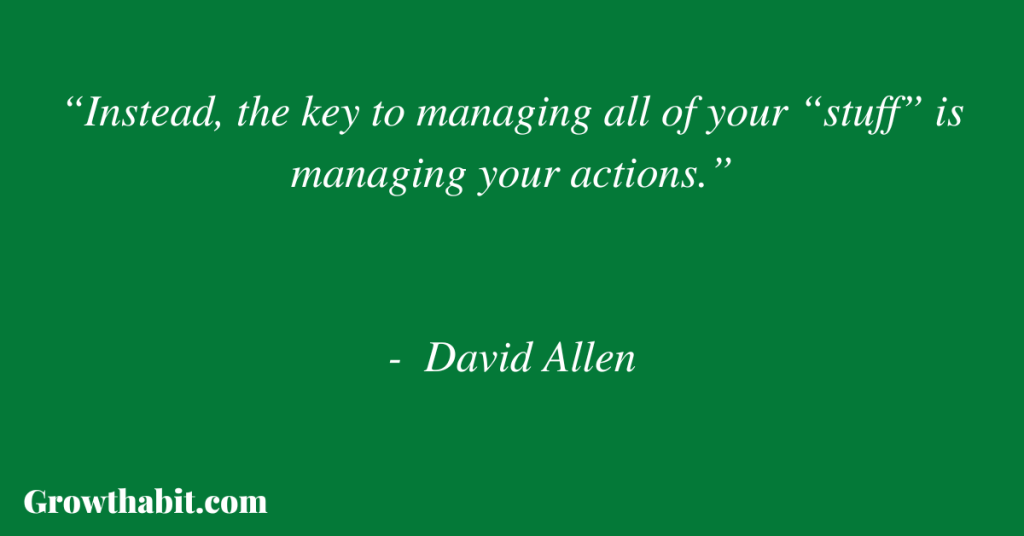
“Anything that causes you to overreact or underreact can control you, and often does. Responding inappropriately to your e-mail, your staff, your projects, your unread magazines, your thoughts about what you need to do, your children, or your boss will lead to less effective results than you’d like.
Most people give either more or less attention to things than they deserve, simply because they don’t operate with a mind like water.”
“Managing commitments well requires the implementation of some basic activities and behaviors:
- First of all, if it’s on your mind, your mind isn’t clear. Anything you consider unfinished in any way must be captured in a trusted system outside your mind, or what I call a collection bucket, that you know you’ll come back to regularly and sort through.
- Second, you must clarify exactly what your commitment is and decide what you have to do, if anything, to make progress toward fulfilling it.
- Third, once you’ve decided on all the actions you need to take, you must keep reminders of them organized in a system you review regularly.”
“[…]But what created that? The answer is, thinking. Not a lot, just enough to solidify your commitment and the resources required to fulfill it.”
“Instead, the key to managing all of your “stuff” is managing your actions.”
“Things rarely get stuck because of lack of time. They get stuck because the doing of them has not been defined.”
“[…] They usually make a list only about the specific area that’s bugging them. But if you made that kind of review a characteristic of your ongoing life- and work style and you maintained it across all areas of your life (not just the most “urgent”), you’d be practicing the kind of “black belt” management style I’m describing.
There is no reason ever to have the same thought twice unless you like having that thought.”
CHAPTER TWO: “Getting Control of Your Life: The Five Stages of Mastering Workflow”
“No matter what the setting, there are five discrete stages that we go through as we deal with our work. We (1) collect things that command our attention; (2) process what they mean and what to do about them; and (3) organize the results, which we (4) review as options for what we choose to (5) do.”
“[…] But we’re talking here about making sure that everything you need is collected somewhere other than in your head.”
“These collection tools should become part of your lifestyle. Keep them close by so no matter where you are you can collect a potentially valuable thought—think of them as being as indispensable as your toothbrush or your driver’s license or your glasses.”
“You should have as many in-baskets as you need and as few as you can get by with.”
“I define a project as any desired result that requires more than one action step.”
“You don’t actually do a project; you can only do action steps related to it. When enough of the right action steps have been taken, some situation will have been created that matches your initial picture of the outcome closely enough that you can call it ‘done’.”
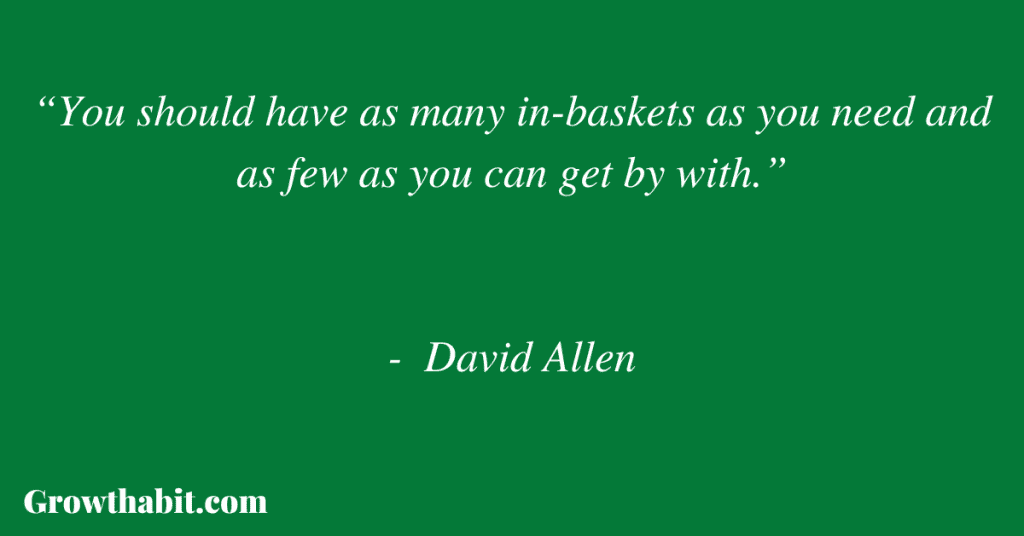
“What does need to be tracked is every action that has to happen at a specific time or on a specific day (enter these in your calendar); those that need to be done as soon as they can (add these to your “Next Actions” lists); and all those that you are waiting for others to do (put these on a “Waiting For” list).”
“Three things go on your calendar:
- time-specific actions;
- day-specific actions; and
- day-specific information”
“At any point in time, knowing what has to get done, and when, creates a terrain for maneuvering.
It’s a good habit, as soon as you conclude an action on your calendar (a meeting, a phone call, the final draft of a report), to check and see what else remains to be done. Review your lists as often as you need to, to get them off your mind.”
“All of your open loops (i.e., projects), active project plans, and “Next Actions,” “Agendas,” “Waiting For,” and even “Someday/ Maybe” lists should be reviewed once a week.”
“The Weekly Review is the time to
- Gather and process all your “stuff.”
- Review your system.
- Update your lists.
- Get clean, clear, current, and complete.”
“The more complete the system is, the more you’ll trust it. And the more you trust it, the more complete you’ll be motivated to keep it.”
“Most people feel best about their work when they’ve cleaned up, closed up, clarified, and renegotiated all their agreements with themselves and others. Do this weekly instead of yearly.”
CHAPTER THREE: “Getting Projects Creatively Under Way: The Five Phases of Project Planning”
“The goal is to get projects and situations off your mind, but not to lose any potentially useful ideas.”
“You can try it for yourself right now if you like. Choose one project that is new or stuck or that could simply use some improvement. Think of your purpose.
Think of what a successful outcome would look like: where would you be physically, financially, in terms of reputation, or whatever? Brainstorm potential steps. Organize your ideas. Decide on the next actions. Are you any clearer about where you want to go and how to get there?”
“If you’re waiting to have a good idea before you have any ideas, you won’t have many ideas.”
“The reactive style is the reverse of the natural model. It will always come back to a top-down focus. It’s not a matter of whether the natural planning will be done—just when, and at what cost.”
“Organizing usually happens when you identify components and subcomponents, sequences or events, and/or priorities. What are the things that must occur to create the final result? In what order must they occur? What is the most important element to ensure the success of the project?”
Part II – Practicing Stress-Free Productivity
CHAPTER FOUR: “Getting Started: Setting Up the Time, Space, and Tools”
“You increase your productivity and creativity exponentially when you think about the right things at the right time and have the tools to capture your value-added thinking.”
“You’ll need a physical location to serve as a central cockpit of control. If you already have a desk and office space set up where you work, that’s probably the best place to start.
If you work from a home office, obviously that will be your prime location. If you already have both, you’ll want to establish identical, even interchangeable systems in both places.”
“You must have a focused work space—at home, at work, and if possible even in transit.”
“Moment-to-moment collecting, thinking, processing, and organizing are challenging enough; always ensure that you have the tools to make them as easy as possible.”
“One of the best tricks for enhancing your personal productivity is having organizing tools that you love to use.”
“You must feel equally comfortable about filing a single piece of paper on a new topic—even a scribbled note—in its own file as you would about filing a more formal, larger document.
Because it requires so much work to make and organize files, people either don’t keep them or have junked-up cabinets and drawers full of all sorts of one-of-a-kind items, like a menu for the local take-out café or the current train schedule.”
CHAPTER FIVE: “Collection: Corralling Your Stuff”
“The best way to create a clean decision about whether something should go into the in-basket is to understand clearly what shouldn’t go in.
Here are the four categories of things that can remain where they are, the way they are, with no action tied to them: Supplies, Reference material, Decoration, Equipment;”
“If you can’t deal with the action in the moment, and you still just have to have the reminder right in front of you, go ahead and create an “emergency” stack somewhere close at hand.
It’s not an ideal solution, but it’ll do. Keep in mind that some potential anxiousness is going to surface as you make your stuff more conscious to you than it’s been. Create whatever supports you need.”
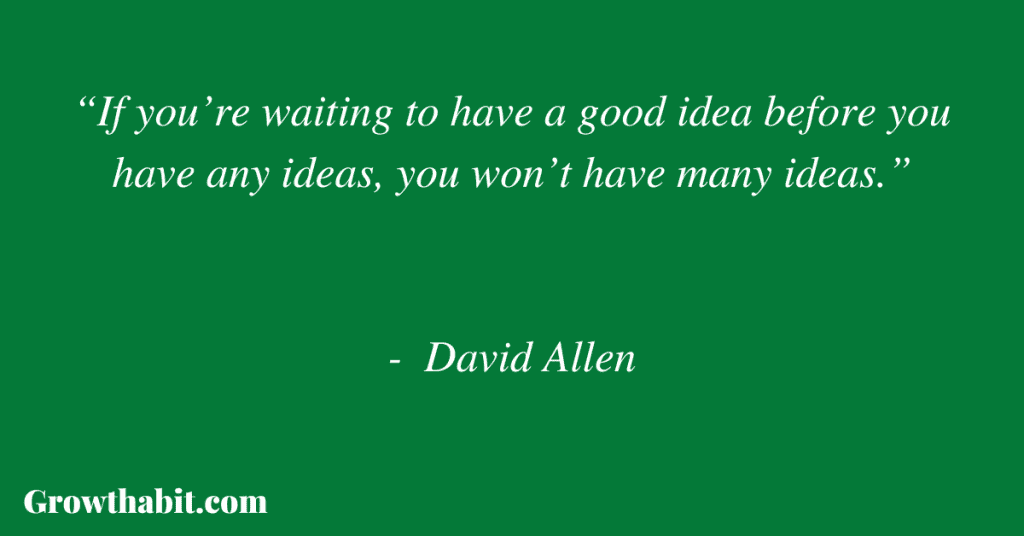
“Once you feel you’ve collected all the physical things in your environment that need processing, you’ll want to collect anything else that may be residing in your psychic RAM.
What has your attention that isn’t represented by something already in your in-basket? This is where the stack of plain paper really comes into play. I recommend that you write out each thought, each idea, each project or thing that has your attention, on a separate sheet of paper.”
“If your head is empty of everything, personally and professionally, then your in-basket is probably quite full, and likely spilling over.
In addition to the paper-based and physical items in your in-basket, your inventory of “in” should include any resident voice-mails and all the e-mails that are currently staged in the “in” area of your communication software.
It should also include any items on your organizer lists for which you have not yet determined next actions.”
CHAPTER SIX: “Processing: Getting “In” to Empty”
“Getting “in” to empty doesn’t mean actually doing all the actions and projects that you’ve collected. It just means identifying each item and deciding what it is, what it means, and what you’re going to do with it.
When you’ve finished processing “in,” you will have 1. | trashed what you don’t need; 2. | completed any less-than-two-minute actions; 3. | handed off to others anything that can be delegated; 4. | sorted into your own organizing system reminders of actions that require more than two minutes; and 5. | identified any larger commitments (projects) you now have, based on the input.”
“The best way to learn this model is by doing. But there are a few basic rules to follow:
- Process the top item first.
- Process one item at a time.
- Never put anything back into in.”
“Remember, multitasking is an exception—and it works only if you hold to the discipline of working through every item in short order, and never avoid any decision for longer than a minute or two.”
“Since no action is required on it, it’s just a matter of physical space and logistics.”
“The Action Step Needs to Be the Absolute Next Physical Thing to Do!”
CHAPTER SEVEN: “Organizing: Setting Up the Right Buckets”
“There are seven primary types of things that you’ll want to keep track of and manage from an organizational perspective:
- A “Projects” list
- Project support material
- Calendared actions and information
- “Next Actions” lists
- A “Waiting For” list
- Reference material
- A “Someday/Maybe” list.”
“Think carefully about where and how you can and can’t do which actions, and organize your lists accordingly.”
“In order to hang out with friends or take a long, aimless walk and truly have nothing on your mind, you’ve got to know where all your actionable items are located, what they are, and that they will wait. And you need to be able to do that in a few seconds, not days.”
“The only time you should have attention on your reference material is when you need to change your system in some way because you have too much or too little information, given your needs or preferences.”
“It’s OK to decide not to decide—as long as you have a decide-not-to-decide system.”
CHAPTER EIGHT: “Reviewing: Keeping Your System Functional”
“A few seconds a day is usually all you need for review, as long as you’re looking at the right things at the right time.”
“This review process is common sense, but few of us do it as well as we could, and that means as regularly as we should to keep a clear mind and a sense of relaxed control.”
“If you have the luxury of an office or work space that can be somewhat isolated from the people and interactions of the day, and if you have anything resembling a typical Monday-to-Friday workweek, I recommend that you block out two hours early every Friday afternoon for the review.”
CHAPTER NINE: “Doing: Making the Best Action Choices”
“[…] I have found three priority frameworks to be enormously helpful in the context of deciding actions:
- The four-criteria model for choosing actions in the moment
- The threefold model for evaluating daily work
- The six-level model for reviewing your own work;”
“To ignore the unexpected (even if it were possible) would be to live without opportunity, spontaneity, and the rich moments of which “life” is made. —Stephen Covey”
“The best place to succeed is where you are with what you have. —Charles Schwab”
“When you’re not sure where you’re going, you’ll never know when enough is enough.”
CHAPTER TEN: “Getting Projects Under Control”
“The middle of every successful project looks like a disaster. —Rosabeth Moss Cantor”
“There are two types of projects, however, that deserve at least some sort of planning activity: (1) those that still have your attention even after you’ve determined their next actions, and (2) those about which potentially useful ideas and supportive detail just show up.”
“Clear the deck, create a context, and do some creative project thinking. You’ll then be way ahead of most people.”
“Let our advance worrying become advance thinking and planning. —Winston Churchill”
Part III – The Power of the Key Principles
CHAPTER ELEVEN: “The Power of the Collection Habit”
“The sense of anxiety and guilt doesn’t come from having too much to do; it’s the automatic result of breaking agreements with yourself.”
“It is the act of forgiveness that opens up the only possible way to think creatively about the future at all. —Father Desmond Wilson”
“Organizations must create a culture in which it is acceptable that everyone has more to do than he or she can do, and in which it is sage to renegotiate agreements about what everyone is not doing.“
CHAPTER TWELVE: “The Power of the Next-Action Decision”
“When a culture adopts “What’s the next action?” as a standard operating query, there’s an automatic increase in energy, productivity, clarity, and focus.”
“For just that reason, what kinds of people would logically be the most resistant to being reminded about a project like that—that is, who would procrastinate the most?
Of course, it would be the most creative, sensitive, and intelligent people! Because their sensitivity gives them the capability of producing in their minds lurid nightmare scenarios about what might be involved in doing the project, and all the negative consequences that might occur if it weren’t done perfectly! They just freak out in an instant and quit!”
“I am an old man and have known a great many troubles, but most of them never happened. —Mark Twain”
“No matter how big and tough a problem may be, get rid of confusion by taking one little step toward solution. Do something. —George F. Nordenholt”
“Avoiding action decisions until the pressure of the last minute creates huge inefficiencies and unnecessary stress.”
“One of the biggest productivity leaks I have seen in some organizations is the lack of next actions determined for “long-term” projects. “Long-term” does not mean “Someday/Maybe.”
CHAPTER THIRTEEN: “The Power of Outcome Focusing”
“The challenge is to marry high-level idealistic focus to the mundane activity of life. In the end they require the same thinking.”
“A vision without a task is but a dream, a task without a vision is drudgery, a vision and a task is the hope of the world. —From a church in Sussex, England, ca. 1730”
Book Review (Personal Opinion):
As a person who always feels guilty about my time management and lack of productivity but still wants to do more, I think I found the main problem and solution in this book.
Years before, I was trying to use every single planner and planning method which fell into my hands, but I ended up in a loop of scratching my undone things and not knowing which task to put on my TO-DO list.
Right because of that, I think this is one of the best self-help books I have ever read. It guides you through the whole process of organization and teaches you how to decide what to do in any specific situation you would get into.
And the main thing, this book went deeper and explained why I felt guilty even if I am doing so many things every day – simply because our mind works like that, and we need to organize it before our tasks and days.
Rating: 9/10
This Book Is For:
- Every business person who ever experienced burn-out
- People with too many areas of responsibility
- Young people who feel guilty about their procrastination
If You Want To Learn More
There is the GTD Newsletter and connecting club where you can find new information about this book, events, as well as your local GTD partner: https://gettingthingsdone.com/
How I’ve Implemented The Ideas From The Book
After reading the first fifty pages of this book, I just ask myself “Where this book was five years ago?”.
I tried so hard to multi-tasking all my tasks, hobbies, and life responsibilities without losing focus and quality, but in the long run, it was impossible. So after I come to the main part of the book and the actual steps, I decided to work and read parallel, so the answer is – I started implementing the GTD system.
One Small Actionable Step You Can Do
Of course, you can find a lot of small tips and tricks in this book and implement them in your organizing plan if that plan works for you.
No one says that you need to change your organizing system if it works for you, but the main key and step you need to take in order to succeed is – to start to believe in your system. If you cannot, then find what you miss and change it with the bunch of advice from this guide – book.
